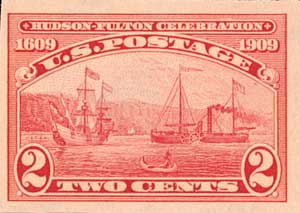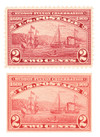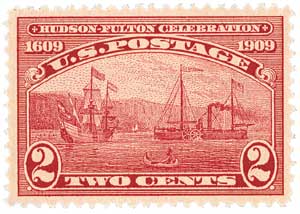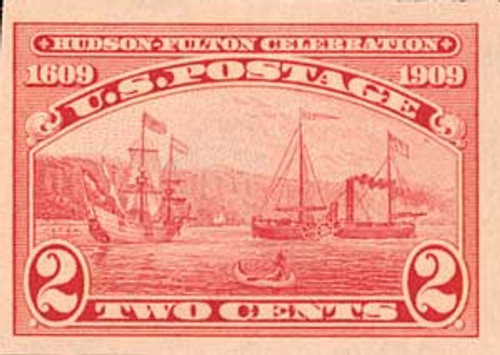
# 372-73 - Complete Set, 1909 Hudson-Fulton Issue
Henry Hudson Sails The Hudson River
Henry Hudson Sails The Hudson River
Born in England around 1565, little is known of Hudsons early life, though its believed he spent many years at sea working his way up from cabin boy to captain. In 1607, he was hired to find a northern route to the Pacific coast of Asia.

That May, Hudson and his 10-man crew sailed the Hopewell, reaching Greenland in June. Along that journey, they named several sites, including Youngs Cape, Mount of Gods Mercy, Hold-with-Hope, and the Great Indraught. Hudson made a second journey in 1608, this time traveling east around northern Russia. However, they encountered heavy ice and had to turn back.

In 1609, Hudson was selected by the Dutch East India Company in the Netherlands to search for an eastern passage to Asia. While preparing for his trip, he heard about a northwest route through North America. He departed Amsterdam on April 4 aboard the Halve Maen(Half Moon).
Hudson was unable to complete the trip, as he again encountered ice. So in mid-May, he turned the ship around to search for the passage through North America, even though that was outside of his orders. Hudsons party reached the Grand Banks of Newfoundland on July 2 and landed near LaHave, Nova Scotia later that month. After staying there for some time, they sailed south, reaching Cape Cod in early August. They then sailed south to the Chesapeake Bay before turning back north and finding the Delaware Bay.

On September 3, Hudson reached an estuary of the North River and on September 11, sailed into the upper bay. On September 12, he began sailing up the river. While Europeans had seen it before him, he explored it significantly. Hudson spent 10 days traveling up the river, reaching present-day Albany. Unable to find the Northwest Passage, he decided to return to Europe later that month. Though the river was known by many names, around 1740 it was referred to as the Hudson River and eventually, the name was officially adopted.
As for Hudson, he went on another voyage in 1610, this time for the Virginia Company and the British East India Company. During that trip, they reached the Hudson Strait and Hudson Bay, believing they'd finally found the passage. When the ship became trapped in the ice, they decided to stay and wait out the winter.

By spring, Hudson was ready to get back on the ship and continue searching for the passage. However, his crew all wished to return home and launched a mutiny in June. Reportedly, the mutineers took control of the ship and placed Hudson, his son, and a few others in a small boat, abandoning them in Hudson Bay. Nobody knows what became of them, as they were never seen or heard from again.
Henry Hudson Sails The Hudson River
Henry Hudson Sails The Hudson River
Born in England around 1565, little is known of Hudsons early life, though its believed he spent many years at sea working his way up from cabin boy to captain. In 1607, he was hired to find a northern route to the Pacific coast of Asia.

That May, Hudson and his 10-man crew sailed the Hopewell, reaching Greenland in June. Along that journey, they named several sites, including Youngs Cape, Mount of Gods Mercy, Hold-with-Hope, and the Great Indraught. Hudson made a second journey in 1608, this time traveling east around northern Russia. However, they encountered heavy ice and had to turn back.

In 1609, Hudson was selected by the Dutch East India Company in the Netherlands to search for an eastern passage to Asia. While preparing for his trip, he heard about a northwest route through North America. He departed Amsterdam on April 4 aboard the Halve Maen(Half Moon).
Hudson was unable to complete the trip, as he again encountered ice. So in mid-May, he turned the ship around to search for the passage through North America, even though that was outside of his orders. Hudsons party reached the Grand Banks of Newfoundland on July 2 and landed near LaHave, Nova Scotia later that month. After staying there for some time, they sailed south, reaching Cape Cod in early August. They then sailed south to the Chesapeake Bay before turning back north and finding the Delaware Bay.

On September 3, Hudson reached an estuary of the North River and on September 11, sailed into the upper bay. On September 12, he began sailing up the river. While Europeans had seen it before him, he explored it significantly. Hudson spent 10 days traveling up the river, reaching present-day Albany. Unable to find the Northwest Passage, he decided to return to Europe later that month. Though the river was known by many names, around 1740 it was referred to as the Hudson River and eventually, the name was officially adopted.
As for Hudson, he went on another voyage in 1610, this time for the Virginia Company and the British East India Company. During that trip, they reached the Hudson Strait and Hudson Bay, believing they'd finally found the passage. When the ship became trapped in the ice, they decided to stay and wait out the winter.

By spring, Hudson was ready to get back on the ship and continue searching for the passage. However, his crew all wished to return home and launched a mutiny in June. Reportedly, the mutineers took control of the ship and placed Hudson, his son, and a few others in a small boat, abandoning them in Hudson Bay. Nobody knows what became of them, as they were never seen or heard from again.







